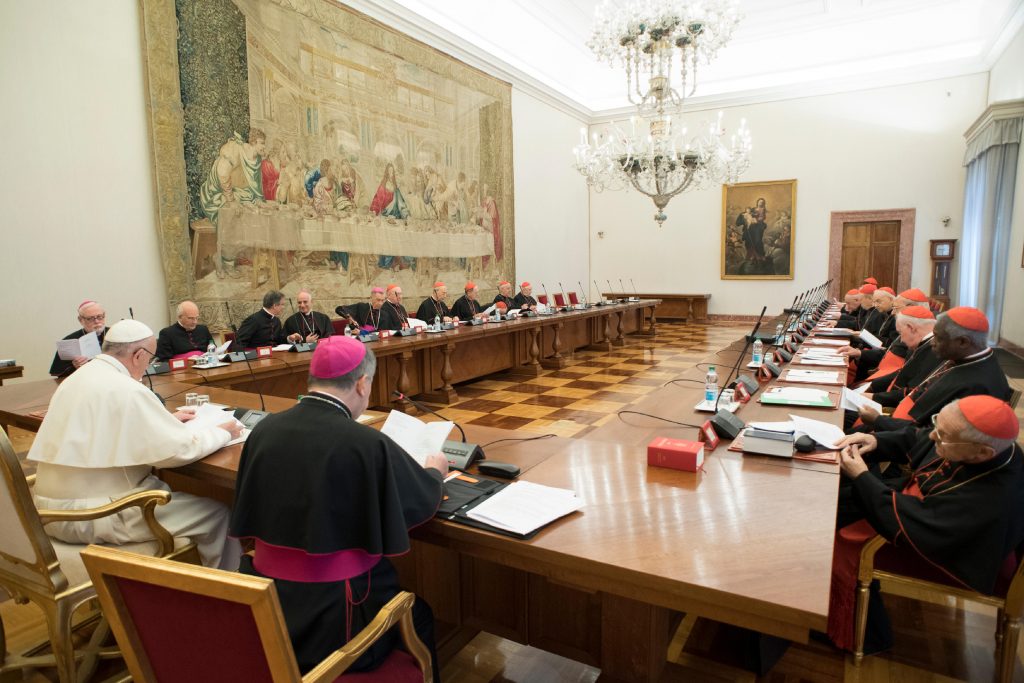ROME — Pope Francis was elected in March 2013 on a reform mandate, and after more than six years of deliberation, it appears that his long-awaited and much-ballyhooed restructuring of the Roman curia is finally on the horizon.
A draft of a new constitution for the Vatican, titled “Praedicate Evangelium” (“Preach the Gospel”), has been making the rounds and could be approved by Francis this summer.
To date, most of the chatter about the potential reform has centered on the creation of a new “Dicastery for Evangelization,” combining two already existing curial offices: The Congregation for the Evangelization of Peoples, commonly known as “Propaganda Fidei,” tasked with overseeing missionary territories, and the Pontifical Council for the Promotion of the New Evangelization, created in 2010 by Pope emeritus Benedict XVI to confront the rapid secularization of Western countries.
Many observers have surmised that the new department will be more powerful than the Congregation for the Doctrine of the Faith, the so-called “Holy Office” that once upon a time was known as “La Suprema” for its preeminence, and consequently have concluded that doctrine is being downgraded in favor of evangelization in the Francis era.
One lesser-noticed codicil of the new apostolic constitution, however, would impose a limit of two terms of five years each, meaning a total of 10 years, for the heads of Vatican dicasteries, who typically are cardinals.
While one certainly understands the desire to supply fresh blood among the Vatican’s most senior officials, ensuring that these jobs don’t become lifetime entitlements for the “old guard,” the law of unintended consequences applies to Rome just as much as anywhere else: In the name of curbing the old guard, such a “reform” could actually reinforce its grip on power.
Here’s why.
In the old days, meaning all the way up to the era of St. Pope Paul VI in the immediate post-Second Vatican Council period, the job of being a prefect of a curial office was, to tell the truth, analogous to the line attributed to John Nance Garner about the vice presidency of the United States: “It’s not worth a bucket of warm spit.”
Generally speaking, curial prefects would come into the office to take meetings and sign correspondence, but the real work of running the department fell to the secretaries, meaning the No. 2 officials, almost all of whom were Italians and veterans of the Vatican bureaucracy since time immemorial.
Domination by the secretaries ensured continuity in governance, but it also meant that the Vatican’s entrenched ways of doing business were virtually immune to challenge.
All that changed in the St. Pope John Paul II era, when prefects actually began to matter. Whether it was then-Cardinal Joseph Ratzinger at the Holy Office, Chilean Cardinal Jorge Medina at the Congregation for Divine Worship and the Discipline of the Sacraments, or Colombian Cardinal Dario Castrillón Hoyos at the Congregation for Clergy, prefects were actually setting policy for the Church and acting as the most prominent spokespersons for the papal regime they served.
Whatever one makes of the direction set by those powerful prefects — and it generally cut in a conservative direction — they at least weren’t Italians or creatures of the Vatican, and they put teeth behind what some share of the world’s bishops thought and felt.
Part of the reason they were able to do so is because they had the time to get their hands around their jobs. Ratzinger, to take the most obvious example, headed the Holy Office from 1981 until his election as Pope Benedict XVI in 2005, a robust 24 years.
Castrillon headed Clergy for 10 years, and probably could have kept going had John Paul not wanted to make room for a curial head from the world’s most populous Catholic nation of Brazil, while Medina only led the liturgical office for six years but had an eventful run.
Not only is making policy for a global Church a complicated business, but the Vatican is an oft-obscure and unique environment that requires time to master. Just ask Ratzinger, who, despite his 24 years of experience, nonetheless struggled to impose a real reform as pope and eventually opted to resign.
When a prefect of a dicastery is naïve, weak, or out of his depth, the obvious beneficiary is the Vatican’s old guard. It’s typically composed of figures who, in one form or another, are beholden to the informal Italian power structure associated with the Secretariat of State. The Vatican, like nature, abhors a vacuum, and these are the personalities most likely to fill it when one arises.
It was this informal old guard that already has all but killed off efforts at real financial reform under Francis, consigning the power of the purse back to the Secretariat of State, and it’s not difficult to imagine their reaction to any other meaningful challenge to the status quo.
To draw the obvious conclusion, an inflexible policy of term limits for dicastery heads could end up impeding the very spirit of collegiality that curial reform, especially under Francis, is intended to serve.
Of course, Francis has never been especially worried about the fine points of Church law and could easily decide on his own to dispense with what limits his own reform imposes. Future popes, however, may not feel quite as free to plot their own course, and so it’s worth thinking about the ways in which laws adopted today could tie their hands.
John L. Allen Jr. is the editor of Crux.
SPECIAL OFFER! 44 issues of Angelus for just $9.95! Get the finest in Catholic journalism with first-rate analysis of the events and trends shaping the Church and the world, plus practical advice from the world’s best spiritual writers on prayer and Catholic living, along with great features about Catholic life in Los Angeles. Subscribe now!

